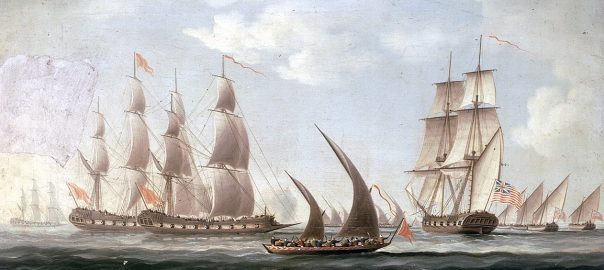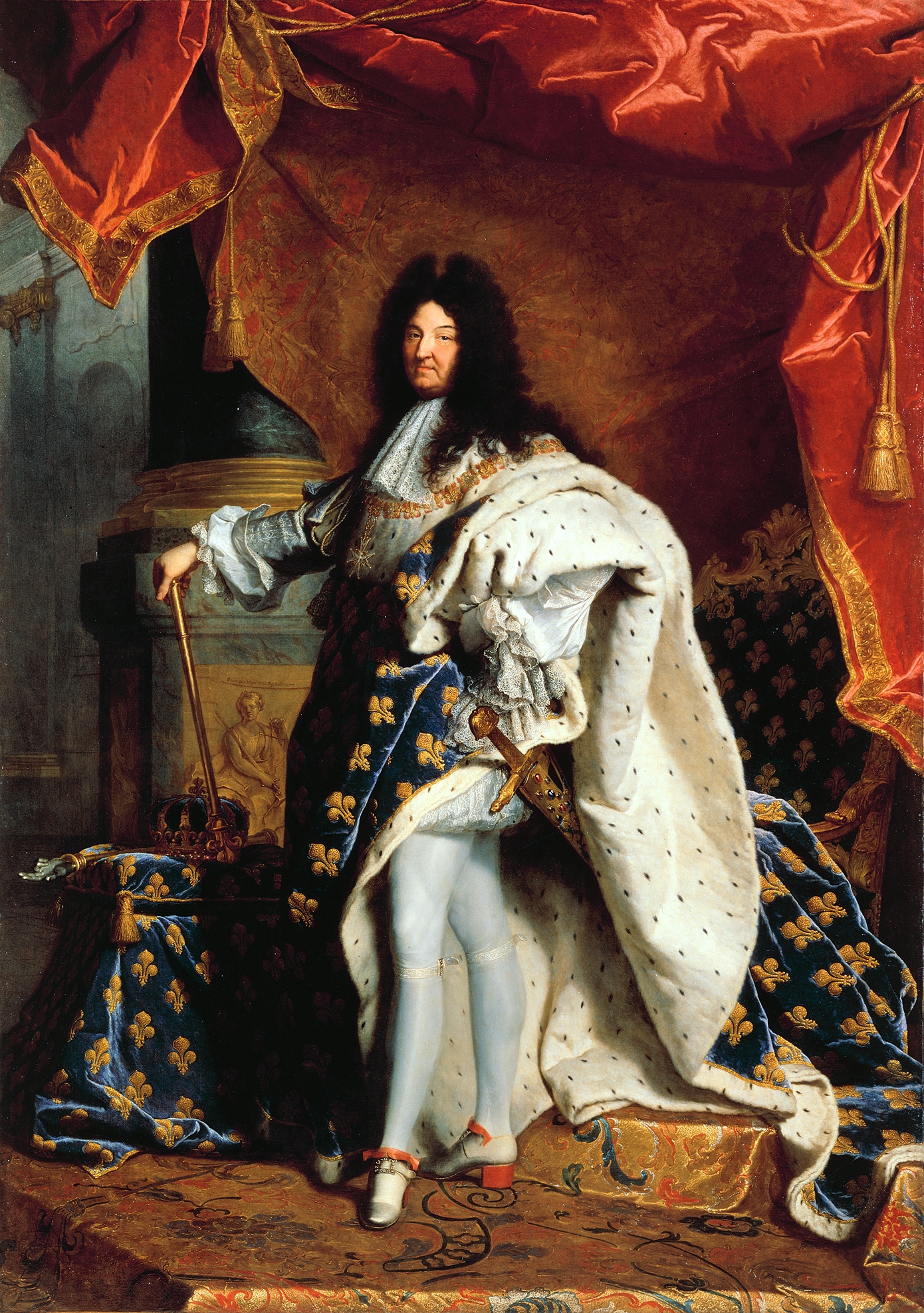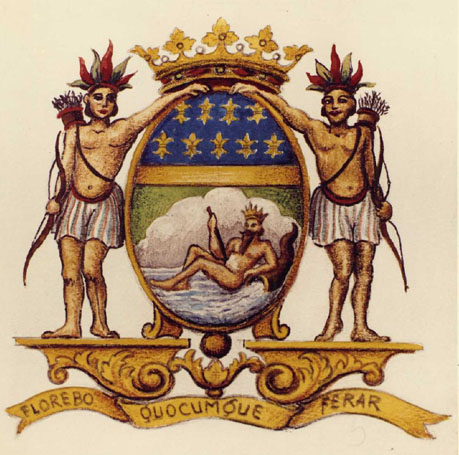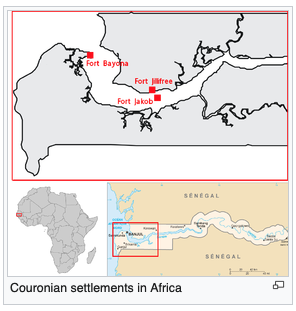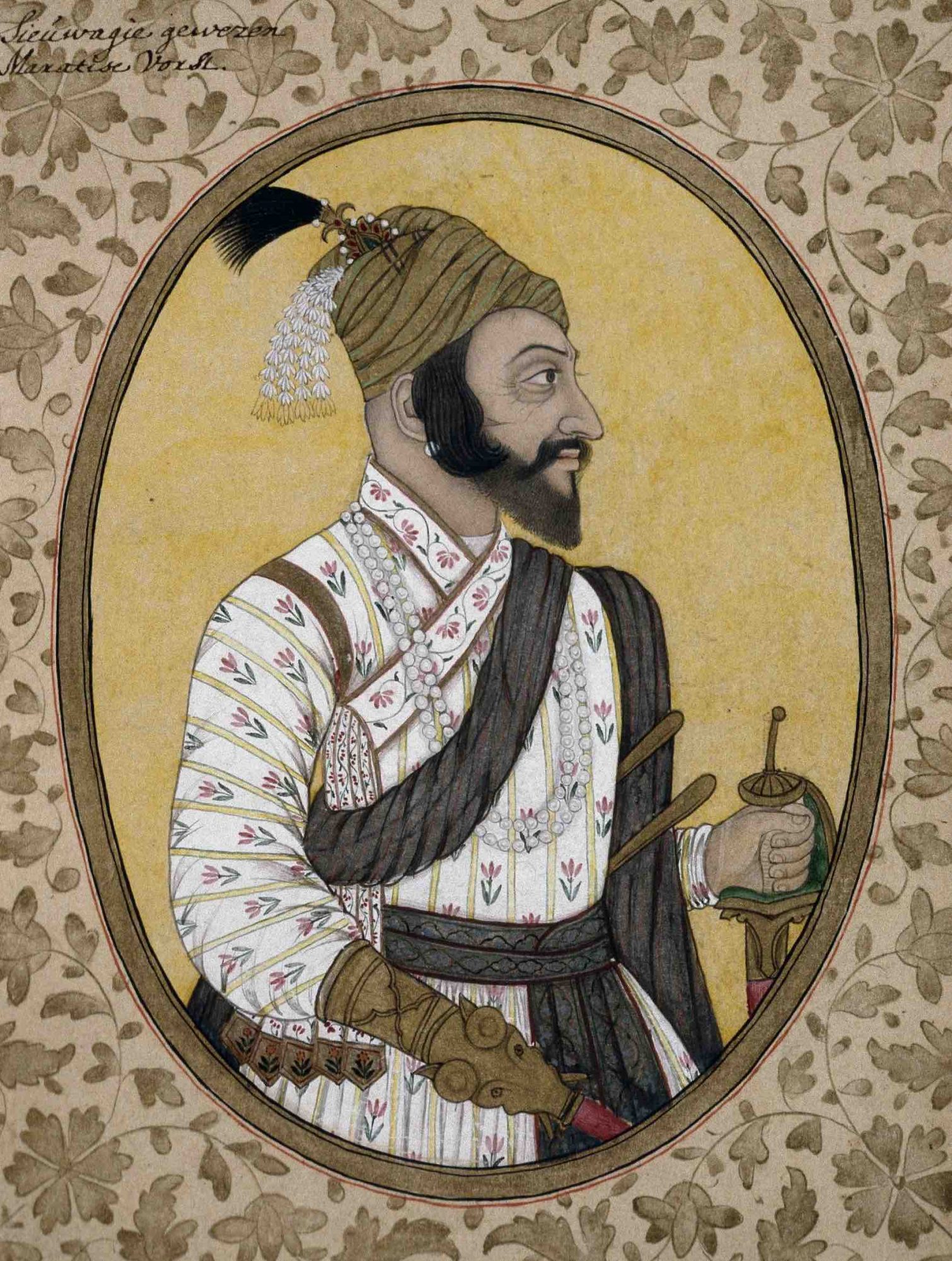I haven’t paid much attention yet to France, where the “Sun King” Louis XIV is now 21 years into what would become a 72-year reign. (But he was a child for the first years and had gained his control of the kingdom only in 1661.) In 1664 CE, he and his able First Minister Jean-Baptiste Colbert made two early probes into empire-building. In today’s bulletin I’ll look at those and also at how easily English naval expeditions were able to pluck two key colonies away from the Dutch: “New Netherland”, and the Gambia. Then I’ll end up with news that augurs trouble ahead for India’s powerful Mughal empire. Read and learn!
Louis XIV moves into empire-building
Louis was young and ambitious and his 45-year-old First Minister, Colbert, was a good administrator who helped implement (or perhaps originated?) Louis’s push to centralize the whole kingdom. One of Colbert’s initiatives was to reorganize France’s then-haphazard series of forays into Indian Ocean trading, raiding, and colony-building, which he did by establishing the French East India Company (French: Compagnie française pour le commerce des Indes orientales) on September 1, 1664 to compete with the English EIC and the Dutch VOC.
English-WP tells us this about the Compagnie:
The initial capital of the revamped Compagnie des Indes Orientales was 15 million livres, divided into shares of 1000 livres apiece. Louis XIV funded the first 3 million livres of investment, against which losses in the first 10 years were to be charged. The initial stock offering quickly sold out, as courtiers of Louis XIV recognized that it was in their interests to support the King’s overseas initiative. The Compagnie des Indes Orientales was granted a 50-year monopoly on French trade in the Indian and Pacific Oceans, a region stretching from the Cape of Good Hope to the Straits of Magellan. The French monarch also granted the Company a concession in perpetuity for the island of Madagascar, as well as any other territories it could conquer.
The Company failed to found a successful colony on Madagascar, but was able to establish ports on the nearby islands of Bourbon and Île-de-France (today’s Réunion and Mauritius). By 1719, it had established itself in India, but the firm was near bankruptcy…
Meantime, looking to another key body of water, Louis and his First Minister decided to tackle the chronic problem of piracy in the Mediterranean by establishing a new, permanent French base at Djidjelli on northeast coast of Algeria. English-WP tells us this about how that went:
The expedition chose to attack a city halfway between Algiers and Tunis. The plan was to seize and fortify it, using it as an advance post for attacks against the corsairs, as the English were then doing from Tangier… This choice led to conflict between the commander of the expedition, his second in command, and the engineer in charge of fortifications. Even before the expedition embarked there was a disagreement between the Duke of Beaufort and the Count of Gadagne who wished to disembark at Bougie…
The fleet mustered in Toulon on 2 July 1664 and made anchor at Bougie on 21 July after stopping in Menorca, where it was joined by Maltese galleys.
On the morning of 23 July 1664, the galleys advanced to shore and threatened the forces defending Djidjelli with their artillery, providing cover for the longboats (chaloupes) to ferry troops to shore near a landmark called le Marabout. The choice of this landing place, which contained a shrine and a cemetery, prompted increased resistance from the inhabitants.
The disembarking army consisted of about 4000 men, and the Maltese battalion 1200 men…The royal troops took Djidjelli the same day without much difficulty. The Count of Vivonne met with stiffer resistance at Le Marabout, but the Kabyles soon abandoned their positions to retreat into the mountains and the expeditionary force set up camp for the night.
It’s worth noting that the forces defending Djidjelli were an uneasy mix of the local garrison of the (Ottoman-affiliated) Regency of Algiers and the local Kabyles (Amazigh, or Berbers) affiliated with the the kingdoms of Koukou and of Béni Abbès.
Anyway, on October 22, a large relief convoy arrived from France to reinforce the French landing force which was now otherwise besieged in Djidjelli. WP tells us this happened:
The convoy also brought a message from the king, who had been informed of the discord between the heads of the expedition. It commanded the Duke of Beaufort to leave command of operations to de Gadagne. Beaufort and his fleet therefore left Djidjelli for good on 22 October.
With the outbreak of plague in Toulon, the departure of any further reinforcements or supplies was cancelled. Still besieged and judging Djidjelli too difficult to hold, the French demolished it’s fortifications and abandoned it, taking ship during the night of 30-31 October 1664. First to be taken aboard were the unreliable elements among the troops, who were “saying out loud that they were going to become Turks”. [!] The retreating forces… arrived in France on 22 October.
On its return to France, the fleet was sent into quarantine at île de Porquerolles [near Toulon] by the Parlement de Provence because of the plague. La Lune, an old three-master, was already in pitiful condition and poorly-repaired. It broke in two and sank near Toulon… with ten companies of the Picardy regiment aboard. More than 700 men drowned… A hundred or so survivors managed to reach Port-Cros, but, abandoned on this desert island 7 km2, they all starved… There were only 24 survivors…
A peace treaty was signed between the Duke of Beaufort and the Regency of Tunis on 25 November 1665. A second treaty was concluded with the Regency of Algiers on 17 May 1666.
England takes over Dutch colonies in N. America, W. Africa

The first of these takeovers was by far the most significant in world-historical terms, replacing “New Netherland” with two colonies now named “New York”, for King Charles’s brother the Duke of York, and “New Jersey”, for old Jersey. English-WP tells us it unfolded thus:
In March 1664, Charles II of England, Scotland, and Ireland resolved to annex New Netherland and “bring all his Kingdoms under one form of government, both in church and state, and to install the Anglican government as in old England”. The directors of the Dutch West India Company concluded that the religious freedom that they offered in New Netherland would dissuade English colonists from working toward their removal. They wrote to Director-General Peter Stuyvesant:
“[W]e are in hopes that as the English at the north (in New Netherland) have removed mostly from old England for the causes aforesaid, they will not give us henceforth so much trouble, but prefer to live free under us at peace with their consciences than to risk getting rid of our authority and then falling again under a government from which they had formerly fled.”
On August 27, 1664, four English frigates led by Richard Nicolls sailed into New Amsterdam’s harbor and demanded New Netherland’s surrender. They met no resistance because numerous citizens’ requests had gone unheeded for protection by a suitable Dutch garrison against “the deplorable and tragic massacres” by the Indians. That lack of adequate fortification, ammunition, and manpower made New Amsterdam defenseless, and the West India Company had been indifferent to previous pleas for reinforcement of men and ships against “the continual troubles, threats, encroachments and invasions of the English neighbors”. Stuyvesant negotiated successfully for good terms from his “too powerful enemies”. In the Articles of Transfer, he and his council secured the principle of religious tolerance in Article VIII, which assured that New Netherlanders “shall keep and enjoy the liberty of their consciences in religion” under English rule. The Articles were largely observed in New Amsterdam and the Hudson River Valley, but were violated along the Delaware River, where Colonel Sir Robert Carr expropriated property for his own use and sold Dutch prisoners of war into slavery. Nicolls eventually forced Carr to return some of the expropriated property. In addition, a Mennonite settlement led by Pieter Corneliszoon Plockhoy near Lewes, Delaware was destroyed.
What were the causes of this so-speedy capitulation? In so many parts of the world, the Dutch colonial forces had been so brutal and successful throughout the whole of the 17th century so far, but in New Amsterdam with its sturdily built star fort strategically located on the southern tip of Manhattan, GWC governor Peter Stuyvesant caved almost immediately.

After his surrender, Stuyvesant returned to Amsterdam to give his own account to the GWC directors of the events that had led to it. You can now read this text in an English translation, at the the end of a fascinating volume Narratives of New Netherland, 1609-1664 edited by J.Franklin Jameson, the full text of which is available online here. (It’s interesting to see these after-action reports that the Dutch company officials gave to their bosses– referred to by Stuyvesant as “Illustrious, High, and Mighty”– in the wake of notable defeats. Just like the one after Koxinga’s amazing rout of the Dutch position in Taiwan in 1661.)
Stuyvesant’s apologia and the text that precedes it in the volume give a much richer view of what caused the collapse of New Netherland in 1664. What came through from my quick reading of Stuyvesant’s apologia is two things:
- His argument that the English colonists in, especially, the colonies to the north/east of New Netherland were much more numerous than the Dutch colonists in New Netherland. He wrote to the directors that the English out-numbered the Dutch “fifty to one”, though the editor of the English translation says it was more like 25,000 to 1,500. But still. (New Netherland had also been squeezed by the expansion of the English colonies to its south/west.)
- His strong complaints that the GWC directors in Amsterdam had not given him and the colony nearly enough support.
Another aspect of this that occurs to me is that the English colonies in “New England” had been founded and were being run as explicitly religious communities, which perhaps therefore had more tendency to social solidarity than the Dutch colony in New Netherland which was composed nearly wholly of traders with little role for the church in its governance.
It’s worth noting, too, that the English takeover of New Netherland was not preceded by any declaration of war. England and the Dutch UP’s were actually in one of the interim phases between two of the wars that marked their relations in those years. In 1667, in a treaty that would end the next of those wars, Netherlands formally ceded New Netherland to the English.
Gambia
This was the other colonial location that England seized, apparently from the Dutch, in 1664. I haven’t been able to find out much about what happened. The Gambia is a river flowing more or less east-to-west on the western bulge of Africa. (Hence, “strategic” for all those colonial companies running trans-Atlantic transport of enslaved Africas to the Americas.) The Dutch had been there, and doubtless before them the Portuguese. But there had also been forts near the Gambia’s estuary that were maintained by the Duchy of Courland and Semigallia (today part of Latvia), which was a vassal state of the Polish–Lithuanian Commonwealth. These were called “Couronian” settlements.
Anyway, in 1664 the London-based Royal African Company (RAC) came into the Gambia. WP tells us that it founded something called Fort James, “on an island about twenty miles up the Gambia river, as a new centre for English trade and power. “
Hindu warrior-king Shivaji sacks wealthy Surat
Aurangzeb had been emperor of the still-growing Mughal Empire in India since 1658, and his maternal uncle Shaista Khan was his Viceroy in the central-India region of Khandesh, which included many areas traditionally inhabited by members of the Hindu Maratha caste, many of whom who had long resisted Mughal rule. One of the notable Maratha leaders was a king called Shivaji Bhonsale I whose grandfather had been an influential general in an earlier sultanate.
Shivaji,who was born in around 1627, had been in and out of alliances with the Mughals. In 1660, Aurangzeb sent Shaista Khan with an army of 80,000 to attack Shivaji and made deep inroads into Maratha territory (which kind of surrounded the Portuguese HQ at Goa on the west coast of India.) WP tells us, here, that Shaista Khan even seized the city of Pune and established his residence at Shivaji’s palace of Lal Mahal.
Okay, before we go any further, here are a couple of maps that I found helpful, courtesy of Wikipedia:


… In 1663, Shivaji launched a surprise counter-attack against Shaista Khan, even cutting off some of Shaista Khan’s fingers as he expelled him from the palace. But Shivaji was short of cash, so his next move was a daring raid deep into Mughal terrain, to sack the very wealthy port city of Surat.
This page on WP tells us the Mughal garrison at Surat had only 1,000 men: “After attacking and then sacking the Mughal garrison, Shivaji attacked the Port of Surat and set the local shipping industry ablaze.” Much more to the point, I think, would have been looting the warehouses, which was what he was there for. He had reportedly brought with him a cavalry of 10,000 men to haul the loot back to his fortress at Raigad. He also, apparently, brought a naval force– see below.
WP continues:
The Mughal Sardar, was very surprised by the suddenness of the attack, unwilling to face the Maratha forces, he hid himself in the Fort of Surat.
Surat was under attack for nearly three days, in which the Maratha Army looted all possible wealth from Mughal and Portuguese trading centers. The Maratha soldiers took away cash, gold, silver, pearls, rubies, diamonds and emeralds from the houses of rich merchants… The business of Mohandas Parekh, the deceased broker of the Dutch East India Company, was spared as he was reputed as a charitable man. Similarly, Shivaji did not plunder the houses of the foreign missionaries. The French traveller Francois Bernier wrote in his Travels in Mughal India:
“I forgot to mention that during pillage of Sourate, Seva-ji, the Holy Seva-ji! Respected the habitation of the reverend father Ambrose, the Capuchin missionary. ‘The Frankish Padres are good men’, he said ‘and shall not be attacked’.”
Shivaji had to complete the sacking of Surat before the Mughal Empire at Delhi was alerted and he could not afford to spend much time attacking the British. Thus, Sir George Oxenden was able to successfully defend the British factory, a fortified warehouse-counting house-hostel.
I think it’s quite likely that it was not lack of time, or a reverence for the Capuchins, that stopped Shivaji and his men from pillaging the European outposts. He was a pretty smart guy. Maybe he saw them as potential allies against the Mughals?
Anyway, he totally succeeded in getting his haul back to his fortress where, WP tells us, it was used “for developing & strengthening the Maratha State.”
And here’s something I found very interesting: One of the steps Shivaji had apparently already taken to strengthen the Maratha State was to build a significant navy for it!
This page on WP tells us this:
In medieval India, the Muslim rulers (such as the Deccan Sultanates and Mughal Sultanate) had mostly ignored the naval arm of their military forces. It may be because they came overland from the North and won decisively in land battles. This scenario changed, however, when the Portuguese arrived in India and started monopolizing and controlling trade on the western coast of the continent. Chhatrapati [King] Shivaji realized the importance of a strong navy; the first keel of a Maratha naval vessel was laid down in a creek near Kalyan circa 1654.
Shivaji took up the task of constructing multiple naval bases along the coast of present-day Maharashtra. He organized two fleets… The Maratha Navy consisted mostly of native Konkani sailors; however, it was commanded mostly by mercenaries, including Siddi and Portuguese. Circa 1659, the Maratha Navy consisted of around 20 warships. Hiring mercenaries was relatively common in Maratha military culture and the Navy was no exception to this practice. The Portuguese naval officer Rui Leitão Viegas was hired as fleet commander, in part because the Maratha wanted to get insight into the Portuguese naval technology and capabilities. The Maratha knew the Portuguese had a powerful navy. The Portuguese convinced their mercenary officers to leave the service of the Maratha; however, the Portuguese allied with the Maratha when the latter went to war against the Mughal Sultanate.
The Battle of Surat of 1664 was a well-coordinated one, whereby the Maratha used their Army and Navy in a coordinated way. In 1679, Chhatrapati Shivaji annexed the island of Khanderi, which was 11 miles (18 km) off the entrance to Mumbai. In response the English and the Siddi repeatedly attacked the island, but they were unable to oust the Maratha from the islands.
As I said, a smart guy. Remember his name.
The banner image above is an English painting of Maratha Navy ships (with red flags) attacking an English sloop near Bombay.
